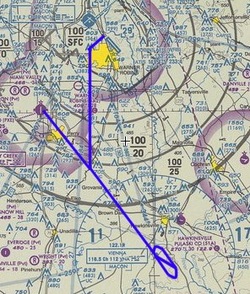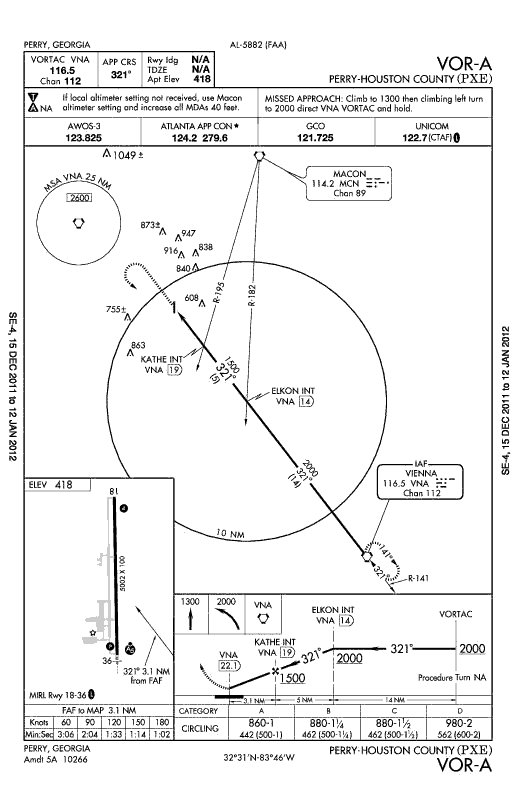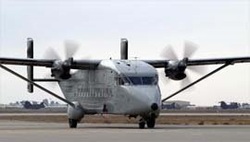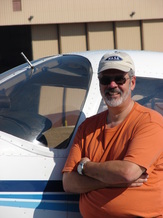Today I flew again with my CFII, flying Instrument Landing System (ILS) and Non-Directional Beacon (NDB) approaches to Perry (KPXE) - one of each. First time to fly an NDB approach.
I flew the ILS to runway 36 first. This was flown as a followup to a ground school question I asked regarding the proper Nav radio setup if approaching the airport from the North. After demonstrating what I had missed in my interpretation of the setup, we flew the full approach which went pretty well. Completed the approach with a go-around, and a turnout to the east.
Turning back to the southwest I tracked the NDB from the northeast, crossed the station, made the procedure turn, flew the Hold, then commenced the final approach. Now throughout this entire approach, as was the case with the ILS, my instructor was broadcasting position reports to PXE traffic - that we were maneuvering, 3 miles south, at xxxx feet.
Leaving the NDB Hold at 1300 feet, he announced again Final approach, 3 miles south, 1300 feet, straight in Runway 36. He no had no more than released the Push-to-talk when he bumped my elbow and stated we had traffic turning left base for runway 36. So an aircraft was turning across our path, 2 miles in front of us. Two miles disappears pretty fast to 90 knots.
I raised my head far enough to see out-side (first time in 45 minutes). It took a couple of seconds for my eyes to focus at a distance and "see" the traffic. There he was, converging from the left, slightly below us. I was now at 1100 feet and descending at 500 feet per minute. I applied power to abort the descent and begin a go-around. As my instructor maintained visual on the traffic, we made another radio call, 2 mile final, 1100 feet, straight in, runway 36. No response, and no indication the converging aircraft saw us.
I turned slightly right and continued a shallow climb, announced a go-around, and watched as we quickly overtook the aircraft now on final actually catching him about the time he touchdown on runway 36.
The aircraft appeared to be a Citabria, and likely flying "No Radio" - perfectly legal. Today was severe clear. I had strobes and the landing light on, the sun was high and behind us - yet he did not see us. The lesson was clear, we are always responsible to see and avoid other traffic. Consider that when dropping out of the clouds at say 1200 feet, there could be traffic flying a low pattern VFR, and they may not have radio. They will not know we are going to come busting into their pattern on a day they don't expect to find anyone flying. Vigilance is the key. Always see and avoid.
If that was not enough to get the adrenaline flowing, my instructor said "lets do a climbing turn to the right and call Atlanta, ask for a practice ILS to Runway 33, and let's take a heading of 120 degrees." At the same time he is reaching over and covering my Attitude Indicator (AI). I have noticed my CFII likes to add workload when the last thing you really want is more workload. I am sure someday I will thank him for it.
The air was full of bumps today, and now my CFII has me flying radar vectors under the watchful eye of the real ATC (rather then him role playing ATC), at the same time flying partial panel at least for the ride over to intercept the approach course.
I really had no problem flying the partial panel - maintained heading, attitude, and altitude very well. Atlanta provided three vectors to get us set up to intercept the localizer. As soon as I made the intercept, Atlanta cleared us for the approach and turned us over to Robins tower.
I flew the approach keeping the needles well centered all the way down to about 350 feet AGL, at which point the my CFII took the controls and I removed the hood. I took the controls back and made a no-flap landing. A little hot, but still a decent landing. It was then that I realized, I flew the vectors and the full approach partial panel - in bumpy air. It is starting to come together :o)
I flew the ILS to runway 36 first. This was flown as a followup to a ground school question I asked regarding the proper Nav radio setup if approaching the airport from the North. After demonstrating what I had missed in my interpretation of the setup, we flew the full approach which went pretty well. Completed the approach with a go-around, and a turnout to the east.
Turning back to the southwest I tracked the NDB from the northeast, crossed the station, made the procedure turn, flew the Hold, then commenced the final approach. Now throughout this entire approach, as was the case with the ILS, my instructor was broadcasting position reports to PXE traffic - that we were maneuvering, 3 miles south, at xxxx feet.
Leaving the NDB Hold at 1300 feet, he announced again Final approach, 3 miles south, 1300 feet, straight in Runway 36. He no had no more than released the Push-to-talk when he bumped my elbow and stated we had traffic turning left base for runway 36. So an aircraft was turning across our path, 2 miles in front of us. Two miles disappears pretty fast to 90 knots.
I raised my head far enough to see out-side (first time in 45 minutes). It took a couple of seconds for my eyes to focus at a distance and "see" the traffic. There he was, converging from the left, slightly below us. I was now at 1100 feet and descending at 500 feet per minute. I applied power to abort the descent and begin a go-around. As my instructor maintained visual on the traffic, we made another radio call, 2 mile final, 1100 feet, straight in, runway 36. No response, and no indication the converging aircraft saw us.
I turned slightly right and continued a shallow climb, announced a go-around, and watched as we quickly overtook the aircraft now on final actually catching him about the time he touchdown on runway 36.
The aircraft appeared to be a Citabria, and likely flying "No Radio" - perfectly legal. Today was severe clear. I had strobes and the landing light on, the sun was high and behind us - yet he did not see us. The lesson was clear, we are always responsible to see and avoid other traffic. Consider that when dropping out of the clouds at say 1200 feet, there could be traffic flying a low pattern VFR, and they may not have radio. They will not know we are going to come busting into their pattern on a day they don't expect to find anyone flying. Vigilance is the key. Always see and avoid.
If that was not enough to get the adrenaline flowing, my instructor said "lets do a climbing turn to the right and call Atlanta, ask for a practice ILS to Runway 33, and let's take a heading of 120 degrees." At the same time he is reaching over and covering my Attitude Indicator (AI). I have noticed my CFII likes to add workload when the last thing you really want is more workload. I am sure someday I will thank him for it.
The air was full of bumps today, and now my CFII has me flying radar vectors under the watchful eye of the real ATC (rather then him role playing ATC), at the same time flying partial panel at least for the ride over to intercept the approach course.
I really had no problem flying the partial panel - maintained heading, attitude, and altitude very well. Atlanta provided three vectors to get us set up to intercept the localizer. As soon as I made the intercept, Atlanta cleared us for the approach and turned us over to Robins tower.
I flew the approach keeping the needles well centered all the way down to about 350 feet AGL, at which point the my CFII took the controls and I removed the hood. I took the controls back and made a no-flap landing. A little hot, but still a decent landing. It was then that I realized, I flew the vectors and the full approach partial panel - in bumpy air. It is starting to come together :o)




 RSS Feed
RSS Feed